 I have visited France four times by now and haven`t once been to its capital. For some reason I feel absolutely indifferent towards the overhyped glamour of Paris. I recognize the cultural impact the city is capable of, but comparing Paris to the whole of France seems unjustified. It is a big and historically and culturally rich country that has a lot to tell. To imagine that everything that the country has to offer could be experienced in one city seems naïve to me. And I have seen enough of it to say that people that restrict themselves to exploring only the country`s capital are missing out. I have been planning my latest trip to France since August. Although towards Jean-Paul Sartre`s political and philosophical views, not unlike the majority of Marxist and post-modernist French philosophers of the time, I feel a certain revulsion and am in a habit of criticizing, his novels and short stories are generally enjoyable reads. Healthy amount of nihilism is entertaining to observe in his characters. This summer I have indulged myself in reading his collection of short stories The Wall. One story in particular called The Childhood of a Leader was especially intriguing. At one point in the story the main character – Lucien – embarks on a trip to Rouen with his friend Bergère. After reading this segment I decided to visit the same city in northern France with my beautiful life’s companion – Anna.
I have visited France four times by now and haven`t once been to its capital. For some reason I feel absolutely indifferent towards the overhyped glamour of Paris. I recognize the cultural impact the city is capable of, but comparing Paris to the whole of France seems unjustified. It is a big and historically and culturally rich country that has a lot to tell. To imagine that everything that the country has to offer could be experienced in one city seems naïve to me. And I have seen enough of it to say that people that restrict themselves to exploring only the country`s capital are missing out. I have been planning my latest trip to France since August. Although towards Jean-Paul Sartre`s political and philosophical views, not unlike the majority of Marxist and post-modernist French philosophers of the time, I feel a certain revulsion and am in a habit of criticizing, his novels and short stories are generally enjoyable reads. Healthy amount of nihilism is entertaining to observe in his characters. This summer I have indulged myself in reading his collection of short stories The Wall. One story in particular called The Childhood of a Leader was especially intriguing. At one point in the story the main character – Lucien – embarks on a trip to Rouen with his friend Bergère. After reading this segment I decided to visit the same city in northern France with my beautiful life’s companion – Anna.
The transport infrastructure of France is fairly unusual compared to the rest of Europe. I could not find any reasonable direct way to travel from Beauvais airport, which is often referred to as Paris Beauvais airport and is located roughly halfway between Paris and Rouen, even though Rouen is a capital of the region of Normandy. There was no direct train or shuttle bus to the city. That seemed quite odd considering the importance, size of Rouen and distance from it (~80 kilometers). After some research I managed to find a reasonably quick though indirect way of getting to Rouen, although we needed to reach the city of Beauvais first.
Early morning stroll towards the city center was invigorating. Damp and warm weather was perfect for our little trip since we decided to skip the bus ride to Beauvais station. Along the way, recognizably French patterns started to emerge. Attention to detail is probably the key that makes up its famous aesthetics. Everything from the house shutters to the sidewalks possess a certain neatness. Most of the time this feeling is created by the subtle underlying decorations that are especially noticeable in the architecture.
At one point the street started to descend towards the city center. By that time we were greeted by the panoramic view and noticed the tips of the cathedral that stood out most of all. Although impressive, it was breathtaking to imagine the grandeur of the Cathédrale Saint-Pierre de Beauvais in its ultimate form that, unfortunately, did not come to pass. The construction of the monument began in 1225 and was supposed to be one of the most ambitious projects of French gothic architecture. Unfortunately, erection of the cathedral was constantly hindered by one unfortunate event after another: argument between the bishop of Beauvais and King Louis IX that culminated in the cut of the funding of the construction of the cathedral and two eventual collapses of the crossing-tower (or the central tower of the cathedral). The crossing-tower that was erected in 1569 made the cathedral a tallest structure in the world. But the title did not stick for long – the second collapse of the tower in 1573 meant the abandonment of the project. By that time, only the choir (the central part of the gothic style cathedrals that resemble the shape of a cross if observed from above) and the transept (the lateral sides of the gothic style cathedral, comparable to the arms of the aforementioned cross) of the cathedral were complete – the whole nave (the ‘corridor’ part of the gothic cathedral, where attendants of the mass are usually located, comparable to the shaft of the aforementioned cross) was missing. Even with the missing parts the cathedral looks huge. Approaching it from the back or the sides one does not even realize that a major part of it is missing. It was rather interesting to be humbled by its grandeur upon the first inspection only to realize later that it was supposed to be even bigger and higher.
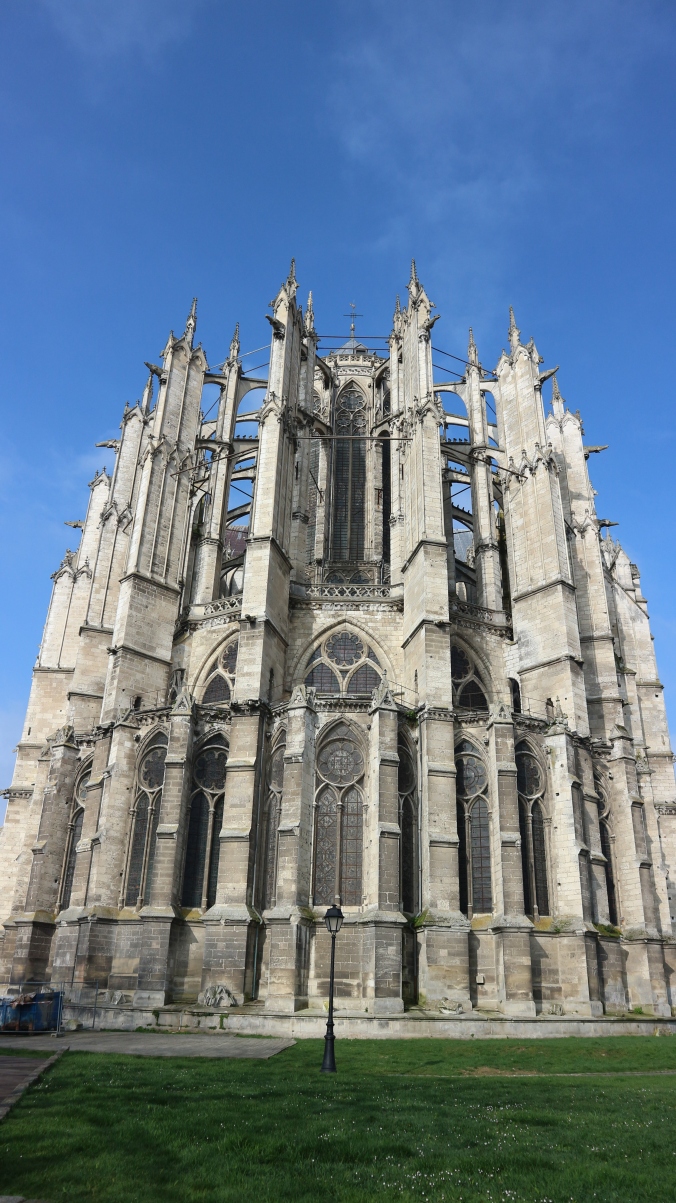
Beauvais Cathedral from the chancel side
Although not as stunning as the cathedral, no less impressive was the neighborhood where the central station of Beauvais was located. I think most of you would agree that area surrounding any given city’s station is rarely an eye candy. Beauvais is an exception. Across the street of the station lies an expansive park with pools and fountains, sculptures and a grotto. You could try to justify this anomaly based on a relatively small size of the city, but I’ve seen my share of train/bus stations around Europe – big and small – and I could say that I was genuinely impressed by the tranquility and maintenance of the area.
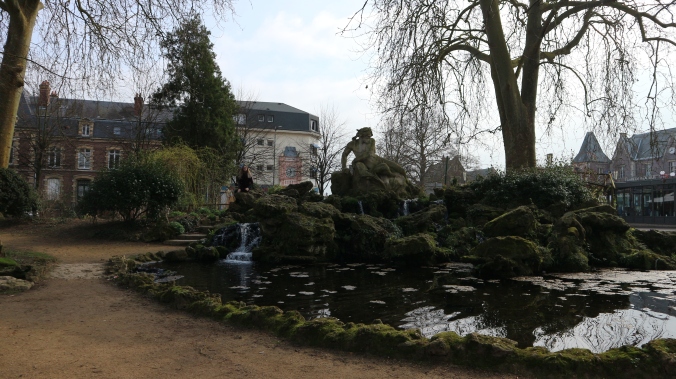
Neighborhood of Beauvais station
Our stay in Beauvais was only a couple of hours long. Our second destination was Abancourt – a small town where we would switch from train to a bus. The peculiar thing about this junction was that we had no information about the bus or the location of its arrival. We tried asking people that disembarked with us, but they did not have any knowledge of that either, although majority of them were going to Rouen. As a best course of action we decided to follow the only people in the station, apart from the employees and waited near the entrance to the building. After a few minutes, a bus stopped in front of us with no visible indication that it is heading for Rouen or a bus number written somewhere (since there was a number of the bus given on the ticket). Communication to the driver revealed that its destination was indeed Rouen, so we had an hour ride through the country side of Normandy, with its winding roads, small villages along both sides of the trail, cattle and sheep farms and apple orchards. It was early March so majority of the plants in Northern France were still dormant.
By the time we got to Rouen, we were aptly tired. Our hotel was situated at the edge of the old town which made it very accessible to dive right into the cultural heart of the city, although we were too worked up to start the exploration upon arrival. We took a relaxing stroll along the main streets of the old town, had a meal and went to the closest supermarket without being especially assertive to pick up some produce that Normandy was known for – namely cheese and cider.
Cider produced in Normandy can be roughly grouped into three categories: Cider Doux, which is sweet cider with alcohol content of around 3%, cider Demi sec, which is semi sweet cider and cider Brut, which is relatively dry and tends to be the strongest of the three. Throughout the trip I only witnessed and tried Doux and Brut ciders, out of which the latter was more to my taste. I have to say the selection of ciders in the general stores and specialized alcohol shops was not dazzling. I was expecting to be greeted by a variety of different brands and types that I have read about before the trip, but reality was a lot less promising. Maybe I did not know where to look, or maybe Rouen citizens were not huge fans of cider – both of these possibilities seem likely. Wine selection, as you would have guessed, was enormous in any store that sold alcohol we visited. It is likely that my cider mecca that I hoped to stumble upon might be located in more remote parts of Normandy.
Camembert is likely the most recognizable of all French cheeses and was first produced in Normandy. It is one of the cheeses that can be found sold at almost any part of France. Our first pick, unfortunately, was not the most representative of this refined produce. Its consistency was granulated, it was rather hard and mild tasting. Later in our journey we had a chance to try some good quality Camembert that Anna aptly indulged in after every consecutive dinner. My stepfather later gave me some advice on detecting decent quality Camembert: at any given store in France, round packaging of the cheese is not sealed and can easily be opened. A way to test it is to poke the body of the product with the finger. Most often than not, good quality Camembert will be soft and easily deformed upon the touch.
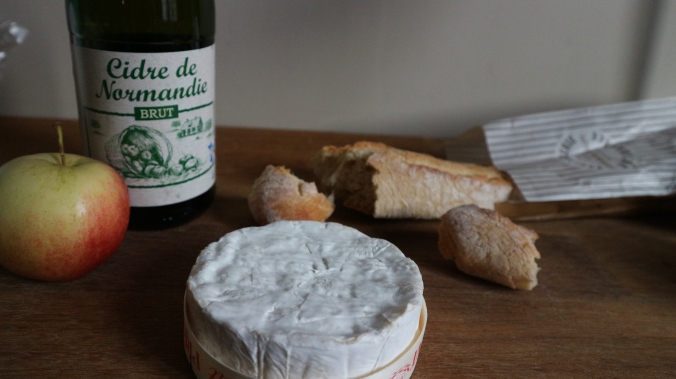
Cidre Brut and Camembert
The following day greeted us with humidity, northern cool and all engulfing fog. It was very refreshing and optimal for exploration. Our first destination was the Rouen cathedral. And it did not disappoint. The only time in my life that I felt a similar sensation was when I stood before the gargantuan cathedral of Cologne. Grey stone, surrounded by thick fog that hid the crossing-tower and the lack of people in the surrounding square created an incredible atmosphere. The amount of detail put into the decoration of the monument was literally dazzling. It was difficult to analyze any single part of the building simply because of the sheer number of surrounding details – it was hard to focus the gaze at any single point and perceive it discriminately.
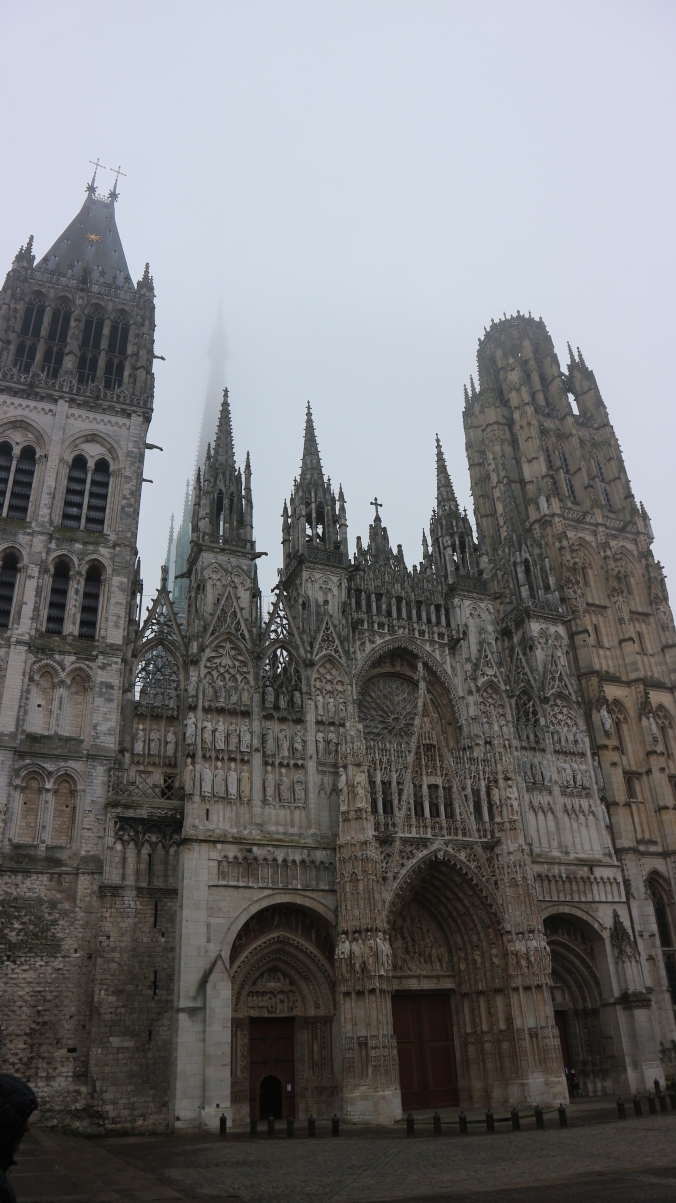
Facade of Rouen Cathedral
Cathédrale Notre-Dame de Rouen is an example of the grandeur of flamboyant Gothic architecture. It is quite fascinating that in one trip I was able to witness two building that at some point in history were the highest structures in the world. At the attempted similar height that the Beauvais cathedral aimed and failed, Rouen cathedral was successful and stands there to prove it to this day. The crossing-tower reaches 151 meters in height. From 1876, when the tower was complete, to 1880 the cathedral held the record of tallest structure in the world, eventually topped by the aforementioned Cologne cathedral. An impressive façade of the monument was recorded by French impressionist Claude Monet in his series of paintings, where the front of the building is depicted in different light and weather conditions.
Woken up from the trance of the big picture I finally got to look more closely into discrete parts of the cathedral. Every tympanum (semi-circular part of the wall above the entrance) has a story to tell. Tympanum of the left entrance (Porte St-Jean) depicts the martyrdom of St. John the Baptist. Although I am not wholly familiar with the context and the underlying story of St. John, it clearly depicted a scene of his decapitation. Tympanum of the central entrance, on the other hand, portrays the family tree of Jesus Christ, although majority of the figures are eroded and damaged.

Tympanum of Porte St-Jean
There is a highly entertaining tale behind the southern tower – the newest addition to the cathedral – which is humorously referred to as Tour de Beurre, which translates to The Butter Tower. The name is likely based on the way its construction was financed. Following the Christian tradition, Lent was prevalent in 15th century Rouen. It is a period of fasting that lasts for six weeks during witch consumption of meat, milk, butter, cheese and eggs was prohibited in medieval Western Europe. There was a way to bypass this law for wealthy enough citizens of Rouen that could buy permits in forms of indulgences from church officials that allowed the consumption of butter (and likely other milk products as well) during Lent. Apparently the tower was built using the funds collected by selling these indulgences.
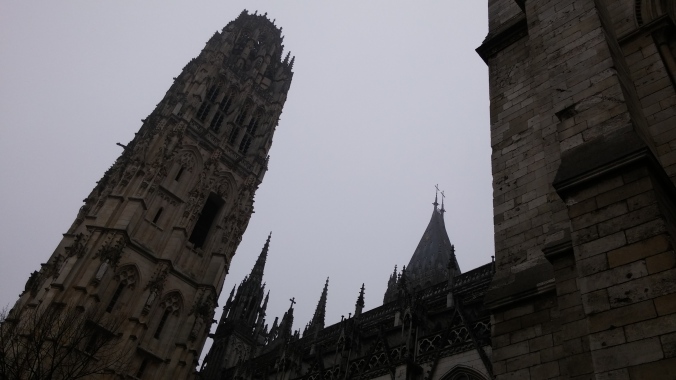
Tour de Beurre
Upon entering the interior I was greeted by grey unmistakably gothic columns and arches that aligned in four stories, each one incrementally shorter than the one bellow. The nave was spotted by numerous chapels on both sides, topped by stained glass windows depicting relevant Christian saints.
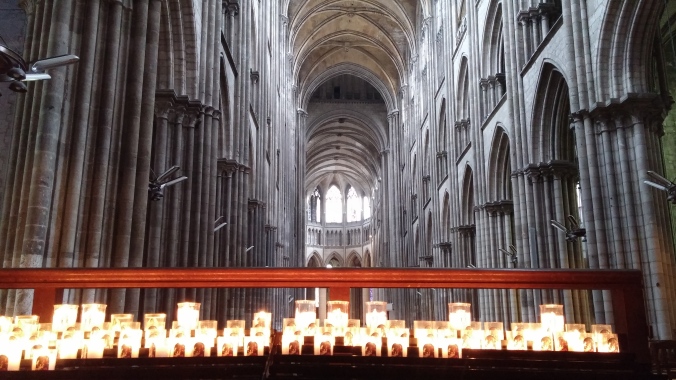
Nave of the Rouen Cathedral
The one that has captivated my attention was of St. Agatha. Suffering and martyrdom is a fundamental part of Catholic tradition and is portrayed in various forms, culminating in the crucifixion of Jesus Christ, although stories of early Christian persecutions and tortures are often even more cruel and vivid. Such was the stained glass window that depicted a blond woman tied to a pole, half naked, and a man behind her with a pair of pincers present suspiciously close to the woman`s breast. I was not aware of the story behind St. Agatha and apparently there aren`t too many accounts of her life. What is known is that she was an early Christian born in Sicily and a person that Governor of Sicily at the time – Quintianus – fell in love with. Agatha refused to reciprocate and thus angered the man to a point where he accused her of Christian superstition and order the torturing. One of those – mostly depicted in art and in this particular stained glass window – was tying her to a pole and ripping her breasts off with iron shears.
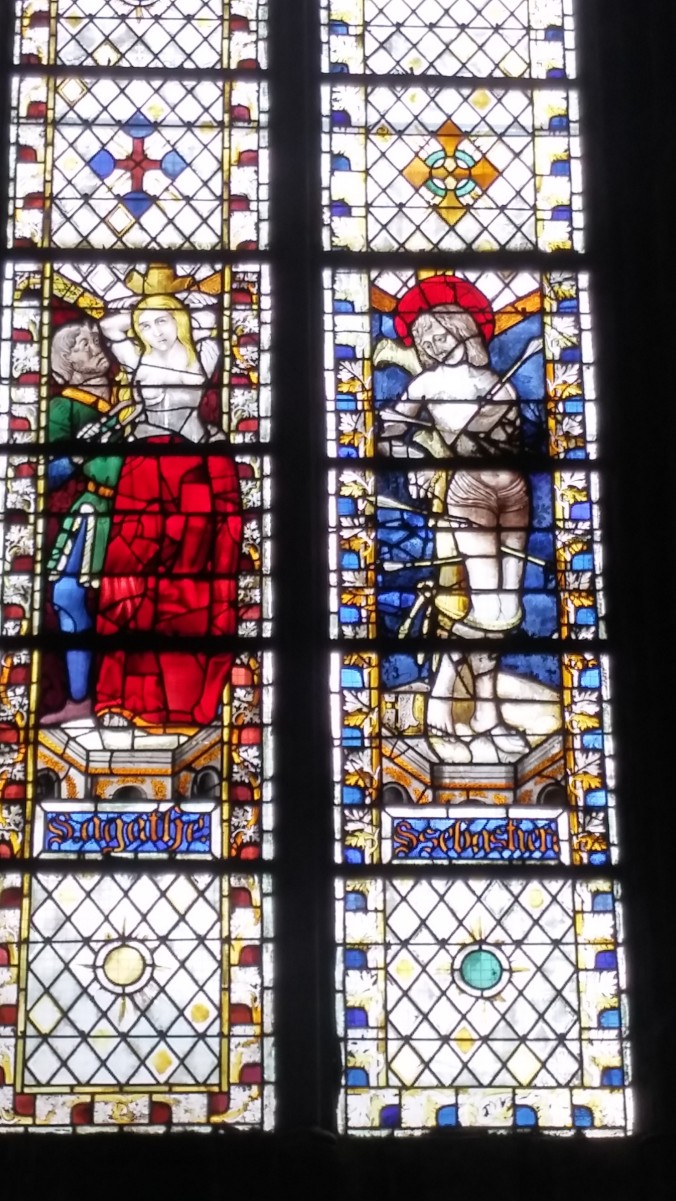
St. Agatha (left)
Walking along the nave I reached the transept and the chorus. Surrounding it are probably the most significant artefacts of the history of Normandy. A good place to start when speaking about Normandy as a separate historical and geopolitical entity is Viking invasion that essentially shaped the further development of the region. And the most prominent figure would be Rollo of Viking descent, who eventually became the first ruler of Normandy. History channel’s Vikings vaguely depict the rise of Rollo and his eventual ties with Frankish king. For a time the Viking was raiding lands up the river Seine, eventually losing The Battle of Chartres in 911 that culminated in a treaty between Rollo and Charles III, king of West Francia, Rollo was baptized, got married to Charles’ daughter, and was given land along the coast of North Sea. In return, he promised to cease the raiding and protect the Frankish lands from further Viking incursions. As is written on his tomb present in the choir, Normandy was “laid waste and established by him”.

Tomb of Rollo, First Duke of Normandy
On the opposing side of the chorus lies the tomb of Rollo`s son, the second Duke of Normandy, William I Longsword. Further down the family line William the Conqueror is born in ~1028. Despite him being the Duke of Normandy, he was not content with the reach of his lands and launched the Norman conquest of England and eventually became the King of England himself. His tomb, though, is located in another Norman city of Caen. From this point on, the lineage of Dukes of Normandy start to intertwine with the history of England, since The Conqueror’s descendants innately hold the titles of Duke of Normandy and King of England. Although Richard the Lionheart is more often depicted in respect to England, he spent very little time there and was occupied with the Crusades and defense of France. He is known as the pinnacle of the line of Dukes of Normandy and his tomb is present in the cathedral, together with the remains of his distant forefathers. At the moment, the actual heart of the Lionheart is contained in the led box that is situated in the treasury of the cathedral.
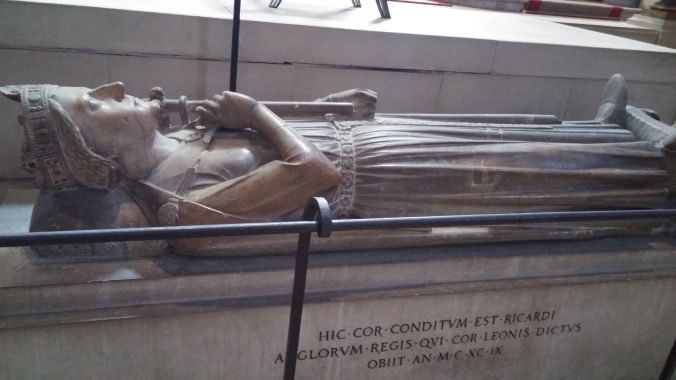
Tomb of Richard the Lionheart
One of the most entertaining parts of the cathedral was the entrance from the left side through the transept called Portail des Libraries, or The Booksellers Portal. The decorations surrounding the portal were exquisite. Tympanium of the entrance depicts The Last Judgment: on the lower panel, people can be seen rising from their graves, and the upper panel portrays the actual judgment, with the unfortunate ones being seized by the devils, situated on the right side of the panel. Upon closer inspection you can see some of the blokes being cooked in a huge pot, while another one is still clenching to his bag of money, even though the claws of the devil are already upon him.
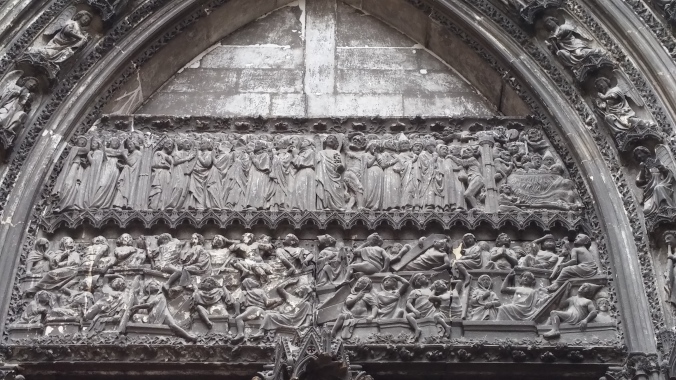
Tympanum of Portail des Libraries
If that wasn`t enough, the whole portal is surrounded by hundreds of small medallions, depicting all manner of beasts, monsters, animals and absurd situations, not unlike things you would find in a medieval bestiary. Some of my favorites were a creature with a body and a head of a pig, a torso and arms of a human that was wearing a monk’s attire and was playing a violin, a headless imp thatwas playing with a human head, and an armless lizard with the hind legs of a goat and a head of Septa Unella.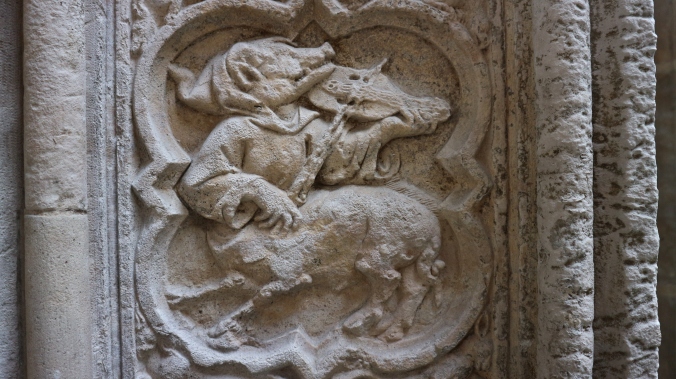
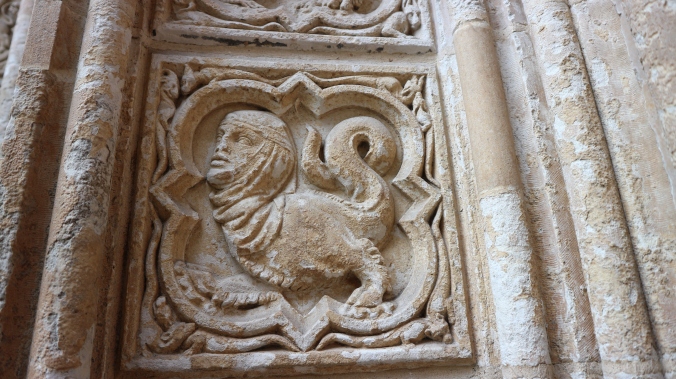
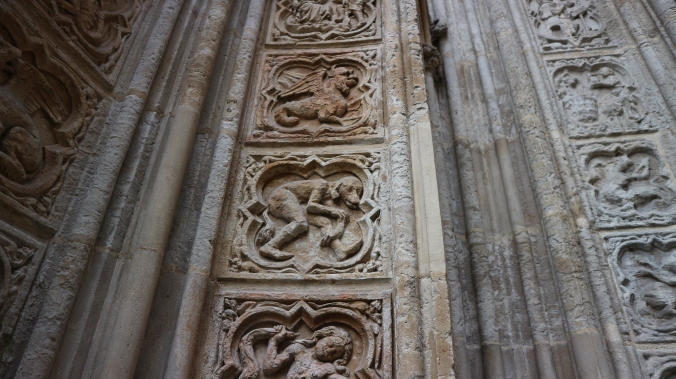
Medallions of Portail des Libraries
I’m surprised you were so close and you didn’t go to Amiens . For many French interested in these things the four major gothic cathedrals of France, in spiritual or political importance, are CHARTRES, which was built exactly above “l’Ombilic des Gaules”,(the navel of Gaul, central telluric point of power for the whole Celtic people, where druids from all Gaul met once a year), REIMS, where all French kings have been crowned, PARIS and AMIENS . Amiens is the widest of all .
In second tier just behind we have BEAUVAIS, ROUEN, BOURGES, ROUEN, TROYES ( cradle of the Knights Templars) and the one I find the most beautiful of all, STRASBURG .,
LikeLike
I heard about the beauty of Chartres Cathedral and how it inspired many artists and musicians. And about the size of Amiens Cathedral. Thank you for these guidlines! I will be visiting France again, I am sure, and these sound like perfect destinations when I will be planning my trip.
LikeLiked by 1 person
A friend of mine one day saw a Gipsy old man scrupulously following the big maze incised in the ground of Chartres . He was wearing fake shoes, well real shoes but without their soles, to not catch attention . Later we learnt that for Gipsy “wizards” Chartres maze was to be walked bare feet in order to recharge human energy .
All these cathedrals above belong to Northern France, (the barbarian part 😉) . For deeper beauty, higher spirituality and powerful energy the Southern half is worthy too .
LikeLike
During the second part of this trip I visited Rhône-Alpes region, particularly Drôme and Ardèche departaments, while last year I visited Savoie departament twice: once in summer and once in winter. I will write about the second part of this trip soon 🙂
Do you have any advice on what is particularly worth seeing in the south?
LikeLike
For me the summum of what I love there are the Cathar strongholds, the fortresses of vertigo on top of the dry eastern Pyrenees, solar temples feeling like in the Andes . By order of preference Peyrepertuse, Montségur, Puylaurens, Quéribus, Lastours .
Of course, the green western Pyrenees are something too,and I spent delicious summers wandering around the southern half of the Massif Central, from Dordogne to Ardèche, camping in the wild .
LikeLike
That sounds awesome. I’ve yet to visit the Pyrenees part of France. I see you have thoroughly explored the whole country. Maybe you would like to have a conversation in a form of a podcast about your experience? I would put it in the blog. You can join me on Facebook (https://www.facebook.com/juozas.grigas) if you are interested.
LikeLike
Allright, but I don’t know what a podcast is, though a blog yes . I try to join on your link .
LikeLike
Pingback: Apie Prancūziją, kuri nėra tik Paryžius – 2 dalis: Ruanas | blogcomposmentis
Pingback: About France that is not only Paris – Part II: Rouen | blogcomposmentis